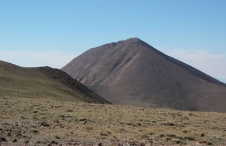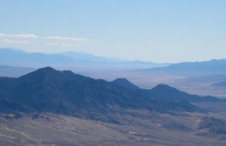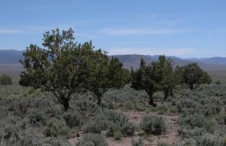Pinyon Jays and Pinyon Pines
In a dry woodland a high-pitched, nasal call is heard in the distance, then another and another. As the calls become louder and more numerous, birds that look like small, stocky, blue crows appear, streaming past in a loose flock of dozens or even hundreds. These are Pinyon Jays (Gymnorhinus cyanocephalus), gregarious birds found throughout most of the state in pinyon-juniper woodlands and known for their close connection to pinyon pines.
Pinyon Jays and pinyon pines (in Nevada, the singleleaf pinyon, Pinus monophylla) interact in a way that benefits both the birds and the trees. Adult Pinyon Jays eat the large, nutritious pine seeds (usually called pine nuts) and also feed the seeds to their nestlings. The birds usually breed in late winter or early spring, relying on seeds they cached in the ground the previous fall. For the pines, seed-caching is key: the jays fail to retrieve some of the hidden seeds, which then may germinate and produce new pine trees. In essence, the birds plant pinyon pine seeds, which might otherwise have a hard time sprouting and establishing themselves as young trees in the arid climate.
The idea that pinyon pines benefit from having their seeds harvested by Pinyon Jays and other seed-caching birds is supported by unusual characteristics of these trees that seem to have evolved specifically to attract such birds. In addition to being relatively large, pinyon pine seeds stay attached to the cone for an unusually long time, which makes harvesting them easier than if they fell to the ground. Also, pinyon seeds that fail to develop completely are tan-colored, while normal seeds are dark brown; this makes it easy for the jays to harvest only the viable seeds (which are the ones worth eating). It is as if the pinyon pines use most of their crop of seeds as attractive “fruits” to ensure that a few seeds will be dispersed to good locations.
For their part, Pinyon Jays have evolved features that make them more efficient harvesters of pine seeds. Unlike other jays, they have no feathers around their nostrils (the scientific name Gymnorhinus means “naked nose”) allowing them to probe deeply into green pine cones without getting fouled with pitch. They also have an expansible esophagus that can be packed with up to 40 pinyon pine seeds. Perhaps most remarkably, each bird can remember most of the thousands of locations where it has stored seeds, even months after caching them.
The total number of Pinyon Jays has been estimated at about 4 million (with some 1.4 million in Nevada), but jay populations likely have risen and fallen with the fortunes of pinyon pines. Within the last 10,000 years, pinyon pines began colonizing the Great Basin from the south, probably bringing Pinyon Jays with them. In the late 1800s, large tracts of pinyon-juniper woodlands were logged to fuel the smelters of the mining industry and, in the 1940s to 1960s, land management agencies in the western U.S. converted about 1.2 million hectares of these woodlands to grasslands for livestock grazing. Both events probably decreased Pinyon Jay populations. Currently, suppression of fires may produce unnaturally dense woodlands that the jays avoid or that lead to catastrophic fires that quickly destroy large areas of jay habitat. Pinyon Jay flocks remain a common sight in Nevada, but the connection of these birds to the fate of pinyon pines makes them sensitive to a variety of human impacts.



